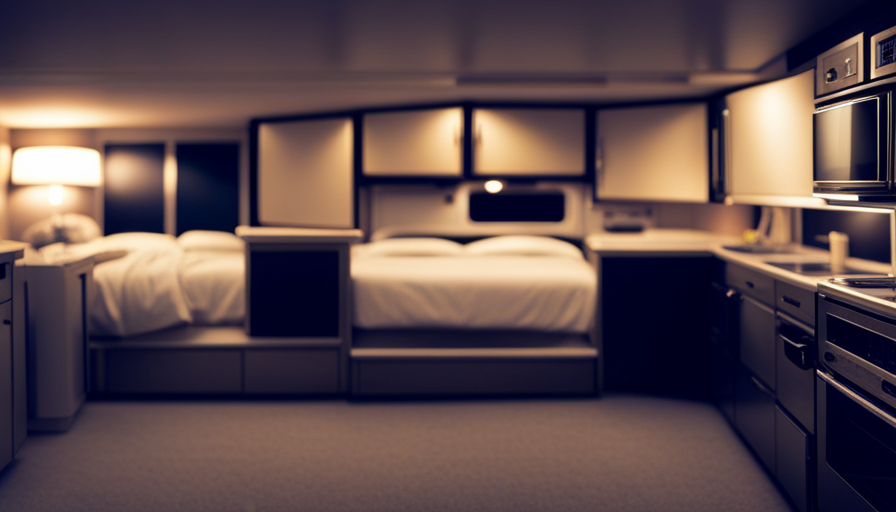We understand that you may be questioning whether or not the size of the inverter for your camper is important. Rest assured, it is a key factor to consider if you want to effectively power all your appliances and devices while traveling.
In this article, we will guide you through the process of determining the right size inverter for your camper.
First, we’ll help you assess your power needs by considering the type of appliances and devices you’ll be using.
Then, we’ll delve into calculating the total power load and choosing an inverter with sufficient power capacity. Efficiency is also a key factor to consider, as it affects how long your battery will last.
Additionally, we’ll touch on the battery capacity and voltage requirements, as well as the installation requirements of the inverter. And don’t worry, if you find yourself unsure about any of these steps, we highly recommend seeking professional advice.
So, let’s dive into the world of inverters and make sure you have the right one to keep your camper fully powered on your adventures.
Key Takeaways
- Determine the power needs of your camper by making a list of appliances and devices and calculating their power consumption
- Choose an inverter with sufficient power capacity and a clean waveform, such as a pure sine wave inverter, to ensure compatibility and avoid issues
- Consider the efficiency rating of the inverter to optimize energy usage and reduce heat generation
- Take into account the battery capacity, voltage requirements, and specific installation requirements when selecting the right inverter for your camper
Assess Your Power Needs
Before you can determine the size of the inverter you need for your camper, it’s crucial to assess your power needs. This step is essential to ensure that you choose an inverter that can handle the electricity demands of your camper.
When assessing your power needs, consider the various appliances and devices you’ll be using, as well as any additional power requirements such as solar power options or generator alternatives.
Start by making a list of all the appliances and devices you plan to use in your camper. This can include things like a refrigerator, microwave, air conditioner, and television. Next, determine the power consumption of each item. This information can usually be found on the appliance itself or in the product manual. Add up the power consumption of all the items to get an estimate of your total power needs.
In addition to the appliances and devices, consider any additional power requirements you may have. For example, if you plan to use solar power options or generator alternatives, you’ll need to account for the power consumption of these systems as well.
By carefully assessing your power needs, you can determine the appropriate size of the inverter for your camper. Now that you have a clear understanding of your power requirements, let’s move on to the next step: determining your power consumption.
Determine Your Power Consumption
To determine the power consumption for your camper, start by assessing the electrical devices you plan to use while on the road. For example, imagine you want to run a mini fridge, charge your phone, and power a small fan during your camping trip. Calculating usage and estimating power consumption will help you determine the size of the inverter you need.
-
Mini Fridge: Consider the power rating of the mini fridge, usually measured in watts. Multiply the power rating by the number of hours you plan to run it each day to calculate the daily energy consumption.
-
Phone Charger: Determine the power rating of your phone charger and multiply it by the number of hours you will charge your phone daily. This will give you the energy consumption of your phone charger.
-
Small Fan: Find the power rating of the fan and multiply it by the number of hours you intend to use it. This will give you the energy consumption of the fan.
By adding up the energy consumption of each device, you can estimate the total power consumption for your camper. This estimation will help you choose an inverter that can handle the total load.
Consider the type of appliances and devices you’ll use next.
Consider the Type of Appliances and Devices You’ll Use
When determining your power consumption, it’s important to consider the type of appliances and devices you’ll be using during your camping trip. Calculating the wattage of these devices is crucial in understanding their electrical requirements and selecting the right size inverter for your camper.
Different appliances and devices have varying power demands, and it’s essential to have a clear understanding of these requirements to ensure a smooth camping experience.
Start by making a list of all the appliances and devices you plan on using. This could include items such as a refrigerator, microwave, TV, laptop, and lights. Look for the wattage rating on each device or appliance. This information can usually be found on the label or in the user manual.
Add up the wattage of all the devices to determine the total power load.
Understanding the electrical requirements of your appliances and devices will help you choose an inverter that can handle the power demands.
In the next section, we’ll discuss how to calculate the total power load and select an appropriate inverter for your camper.
Calculate the Total Power Load
Make a comprehensive list of all the appliances and devices you plan on using during your camping trip, envisioning the power they’ll consume. Calculating the power usage is crucial to determine the appropriate size of the inverter you need for your camper.
To help you with this task, consider the following:
-
Identify the power rating: Look for the power rating label on each device or appliance, usually measured in watts (W) or amps (A). Note down these values for each item on your list.
-
Estimate the usage time: Determine how long you’ll be using each device or appliance. Multiply the power rating by the usage time in hours to calculate the energy consumption in watt-hours (Wh).
-
Add up the energy consumption: Sum up the energy consumption of all the devices and appliances on your list to obtain the total power load. This will give you an estimate of the power requirements for your camper.
-
Consider additional factors: Keep in mind that some appliances may have a higher power surge when they start up, known as the starting or surge power. Take this into account when calculating the total power load.
Calculating the power usage and estimating the power requirements of your camper is essential for choosing an inverter with sufficient power capacity. With these calculations in hand, you can proceed to the next section to find the right inverter for your needs.
Choose an Inverter with Sufficient Power Capacity
Selecting an inverter with enough power capacity is crucial for ensuring a smooth and efficient camping experience.
One interesting statistic to consider is that the average power consumption of common camping appliances ranges from 50 to 500 watts. Therefore, it’s important to choose an inverter that can handle the total power load of all the appliances you plan to use in your camper.
To determine the right power capacity for your inverter, add up the wattage of all the appliances you’ll be using simultaneously. Make sure to consider any power surges or spikes that may occur when appliances start or run at full capacity. It’s recommended to choose an inverter with a power capacity slightly higher than your total calculated load to provide some headroom and avoid overloading the inverter.
Inverter selection isn’t just about the power capacity, but also about the quality of the waveform it produces. Sine wave inverters are generally the best choice as they provide a clean and stable power output, ensuring compatibility with sensitive electronics. Modified sine wave inverters are more affordable but may cause issues with certain appliances.
Consider the waveform type when choosing your inverter for a camper.
Consider the Waveform Type
Imagine enjoying your camping trip with smooth and uninterrupted power supply, thanks to a high-quality sine wave waveform inverter. When choosing an inverter for your camper, it’s crucial to consider the waveform type it produces.
There are two main types of waveforms: modified sine wave and pure sine wave.
Modified sine wave inverters are more affordable and widely available. They produce a waveform that is a stepped approximation of a sine wave. While they can power most common appliances, they may cause issues with sensitive electronics. The irregular waveform can lead to distorted signals, resulting in buzzing noises or reduced performance in certain devices.
On the other hand, pure sine wave inverters produce a smooth and consistent waveform that replicates utility grid power. This makes them suitable for all types of appliances and electronics, including sensitive ones like laptops, medical equipment, and audio/video systems.
However, pure sine wave inverters tend to be more expensive. Despite their higher cost, they offer several advantages, including improved efficiency, reduced heat generation, and longer lifespan for devices. Moreover, they eliminate the risk of damaging your appliances or hearing irritating buzzing noises.
Considering the advantages and disadvantages of modified sine wave vs pure sine wave inverters, it becomes evident that investing in a pure sine wave inverter is a wise choice for your camper.
With this in mind, let’s now look at the inverter’s efficiency and how it affects your power needs.
Look at the Inverter’s Efficiency
Considering the various factors that affect the performance of your power supply, it’s essential to assess the efficiency of the inverter you choose for optimal energy usage during your camping adventures. Assessing efficiency is crucial because it determines how well the inverter converts the DC power from your battery to AC power for your camper’s appliances.
By comparing different inverter models, you can find one that offers the highest efficiency, ensuring that you get the most out of your battery’s capacity. When comparing inverters, it’s important to look at their efficiency ratings. Inverters with higher efficiency ratings convert a larger percentage of the battery’s DC power into AC power, resulting in less energy waste. This means that more power is available for your camper’s appliances, allowing you to run them for longer periods without draining your battery quickly. Additionally, inverters with higher efficiency ratings tend to generate less heat, which can also contribute to increased energy efficiency.
Transitioning into the subsequent section about ‘consider the battery capacity and voltage’, it’s important to take into account not only the inverter’s efficiency but also the battery capacity and voltage. These factors are interconnected and play a significant role in determining the size of the inverter you need for your camper.
Consider the Battery Capacity and Voltage
You might think that the battery capacity and voltage of your camping power supply aren’t important, but trust me, they can make a world of difference in your outdoor adventures.
When it comes to choosing the right inverter for your camper, considering the battery capacity and voltage is crucial. First, you need to determine the type of battery you have in your camper. Different battery types have different voltage outputs and capacities, so it’s important to choose an inverter that’s compatible with your battery.
Additionally, you should also consider the solar panel compatibility with your battery. If you have solar panels installed in your camper, you want to make sure that the inverter you choose is compatible with the voltage and capacity of your battery and can effectively convert the solar energy into usable power for your camper.
Having the right battery capacity and voltage ensures that your inverter can provide sufficient power for your camping needs. It allows you to run appliances and charge devices without draining your battery too quickly. It also ensures that your inverter operates efficiently and doesn’t overload your battery.
Now that we’ve considered the battery capacity and voltage, let’s move on to the next important step: determining the inverter’s installation requirements.
Determine the Inverter’s Installation Requirements
To ensure a successful installation, it’s crucial to determine the specific requirements of the inverter. When it comes to installing an inverter in your camper, there are several important factors to consider. These inverter installation tips will help you make the right choices to ensure optimal performance and functionality.
Firstly, it’s important to consider the power requirements of your camper appliances and devices. This will help determine the wattage capacity of the inverter you need. Additionally, you should take into account the surge power capability of the inverter, which is the ability to handle short bursts of high power demand.
Next, consider the input voltage and the output voltage of the inverter. Ensure that the inverter you choose is compatible with your camper’s battery voltage. This will ensure efficient power conversion and prevent any damage to your electrical system.
Lastly, factors affecting inverter performance should be taken into account. These include the ambient temperature, ventilation requirements, and the distance between the inverter and the battery. Proper ventilation is essential to prevent overheating, and keeping the inverter as close to the battery as possible minimizes power loss.
Determining the installation requirements of your inverter is vital for a successful setup. By considering factors such as power requirements, voltage compatibility, and performance considerations, you can ensure optimal performance and functionality. If unsure about any aspect of the installation process, it’s always recommended to seek professional advice.
Seek Professional Advice if Unsure
If you’re unsure about the installation requirements for your inverter, it’s always a good idea to seek professional advice. Installing an inverter in your camper involves complex electrical work. It’s essential to ensure that it’s done correctly to avoid any potential hazards or damage to your camper’s electrical system.
Professional advice can provide you with the guidance and expertise needed to determine the appropriate size and specifications for your inverter. They can assess your camper’s electrical system and make recommendations based on your power needs and the specific requirements of your appliances and devices.
Furthermore, seeking professional help can help you understand and implement inverter safety precautions. These precautions are crucial to safeguard yourself, your passengers, and your camper from any potential electrical hazards. Professionals can educate you about the proper grounding, wiring, and fuse protection necessary for the safe operation of your inverter.
Remember, when it comes to electrical installations, it’s always better to be safe than sorry. Seeking professional advice ensures that your inverter is installed correctly, and you can enjoy your camper’s electrical system without any worries.
Frequently Asked Questions
Can I use a regular household inverter for my camper?
Oh boy, using a regular household inverter for your camper? Let me tell you, that’s like trying to fit a square peg in a round hole. Sure, you could use a car inverter, but trust me, it’s not the best idea.
Here’s why: a dedicated camper inverter is designed specifically for the needs of your camper. It ensures efficient power conversion, protects your electrical system, and provides the necessary voltage for all your appliances.
So, save yourself the headache and invest in a dedicated camper inverter. Trust me, you won’t regret it.
What are the most common appliances and devices used in a camper?
When choosing the right inverter for your camper, it’s important to consider the most common appliances and devices used in a camper. These typically include a refrigerator, air conditioner, microwave, TV, and charging devices for phones and laptops.
To power these appliances efficiently, it’s essential to select an inverter with the appropriate wattage capacity. By understanding the power requirements of these devices, you can ensure that you choose the right inverter for your camper appliances.
How does the waveform type of an inverter affect its performance?
The waveform type of an inverter greatly impacts its output quality. Specifically, the waveform type refers to the shape of the electrical signal produced by the inverter.
A modified sine wave inverter, for example, creates an electrical signal that approximates a sine wave but with some distortion. While this type of inverter is cost-effective and can power many common appliances, it may not provide the same level of performance and compatibility as a pure sine wave inverter.
What is the average efficiency level of inverters available in the market?
Factors affecting the efficiency of inverters include the waveform type, load capacity, and temperature.
When choosing the right inverter size for your needs, consider the power requirements of your appliances and electronics. Calculate the total wattage needed and choose an inverter that can handle that load. It’s also important to consider the surge power capability, as some appliances require more power when starting up.
Additionally, ensure the inverter can operate within the temperature range of your environment for optimal efficiency.
Can I use multiple batteries to increase the power capacity of my inverter?
Using multiple batteries can indeed increase the power capacity of an inverter for a camper. To calculate the power requirements, you need to consider the appliances you plan to run and their power consumption. Add up the wattage of all the devices and multiply it by the total hours you’ll be using them.
A rule of thumb is to select an inverter that can handle at least 20% more power than your calculated requirements to account for any surges or fluctuations.
Can a Larger Inverter Size Extend the Lifespan of My Camper Battery?
A larger inverter size can potentially extend the camper battery lifespan. By matching the inverter size to the power demands of appliances and devices, it ensures the battery is not strained beyond its capacity. This helps maintain a balanced power supply, reducing wear and tear on the battery and increasing its overall lifespan.
Conclusion
In conclusion, selecting the right size inverter for your camper is crucial to ensure a smooth and efficient power supply. By assessing your power needs and determining your power consumption, you can calculate the total power load and choose an inverter with sufficient power capacity.
Additionally, considering the type of appliances and devices you’ll use is important. It’s also important to look at the inverter’s efficiency, consider the battery capacity and voltage, and determine the installation requirements.
Remember, seeking professional advice if unsure is like navigating uncharted waters with an experienced captain by your side, ensuring a successful voyage.










